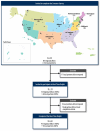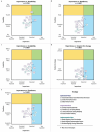Supporting integration of substance use interventions in HIV service organizations: Assessing the fit of 10 strategies for AIDS Education and Training Centers to use
- PMID: 40548261
- PMCID: PMC12179455
- DOI: 10.1177/26334895251343647
Supporting integration of substance use interventions in HIV service organizations: Assessing the fit of 10 strategies for AIDS Education and Training Centers to use
Abstract
Background: People with HIV are more likely than the general population to have a substance use disorder (SUD), which can impact the HIV care continuum. HIV service organizations (HSOs) can implement SUD interventions but may need assistance from support systems like the AIDS Education and Training Center (AETC) network. We assess the fit of strategies AETCs may use to help HSOs integrate SUD interventions.
Method: We invited 74 of 91 AETCs (81.3%) to participate. Using a real-time Delphi approach, 64 AETCs (86.5% of those invited) rated the (a) importance of, (b) feasibility of, (c) readiness to offer, (d) scalability of, (e) pressure to offer, and (f) current need for 10 strategies their AETC could use to help HSOs integrate SUD interventions. Items were examined via confirmatory factor analyses. Responses were summed to create the Setting-Strategy Fit index score. We conducted pairwise t-tests to examine differences in scores between strategies, plotted the mean importance ratings for each strategy against the mean ratings for other criteria to review the strategies' relative viability, and conducted bivariate and multiple regression analyses to examine correlates of the scores.
Results: The items of the Setting-Strategy Fit index showed good internal consistency and model fit. Generally, strategies were considered somewhat important but AETCs felt very little pressure to offer them. Two strategies (disseminating information, providing access to asynchronous training) exceeded the "important" threshold. One strategy (disseminating information) was considered viable for also having high feasibility. Overall, AETCs were only somewhat ready to provide the strategies, which were perceived as only somewhat feasible or currently needed.
Conclusions: Although AETCs recognized the importance of several strategies for helping HSOs integrate SUD interventions, their responses resulted in only one having good fit. These findings can guide efforts to further prepare AETCs to support HSOs and to end the HIV epidemic.
Plain language summary: Strategies AIDS Education and Training Centers Could Use to Help HIV Service Organizations Implement Substance Use Interventions. Why was the study done?: Having a substance use disorder (SUD) can complicate care for people with HIV by reducing their engagement in services. HIV service organizations (HSOs) serve people with HIV but not all of them offer services to address SUD. We assessed the fit of different strategies that AIDS Education and Training Centers (AETCs), which provide technical assistance to HSOs, could use to help HSOs implement SUD interventions.What did the researchers do?: We engaged 74 AETC representatives nationally to rate 10 strategies. They were asked about (a) the importance of the strategies, (b) the feasibility of offering them, (c) their readiness to offer them, (d) the scalability of the strategies, (e) pressure they receive to offer them, and (f) the current need for them. Responses were summed into an index score reflecting the strategies' fit for AETCs to help HSOs integrate SUD interventions. We looked for differences in scores between strategies and plotted the scores for each strategy to identify which are most promising.What did the researchers find?: Two of the strategies (sharing information about the SUD interventions and providing access to asynchronous trainings) exceeded the threshold for being "important." One of those (sharing information) was also considered "feasible" for AETCs to offer, making it the only potentially viable strategy. Overall, AETCs were only somewhat ready to provide the strategies, which they felt very little pressure to offer.What do the findings mean?: Although AETCs recognized the importance of different strategies for helping HSOs implement SUD interventions, they only identified one strategy as having good fit. These findings can guide future efforts to further prepare AETCs to support HSOs and to end the HIV epidemic.
Keywords: Delphi; HIV; implementation strategies; intermediary organizations; substance use disorder.
© The Author(s) 2025.
Conflict of interest statement
The authors declared no potential conflicts of interest with respect to the research, authorship, and/or publication of this article.
Figures
Similar articles
-
How lived experiences of illness trajectories, burdens of treatment, and social inequalities shape service user and caregiver participation in health and social care: a theory-informed qualitative evidence synthesis.Health Soc Care Deliv Res. 2025 Jun;13(24):1-120. doi: 10.3310/HGTQ8159. Health Soc Care Deliv Res. 2025. PMID: 40548558
-
Survivor, family and professional experiences of psychosocial interventions for sexual abuse and violence: a qualitative evidence synthesis.Cochrane Database Syst Rev. 2022 Oct 4;10(10):CD013648. doi: 10.1002/14651858.CD013648.pub2. Cochrane Database Syst Rev. 2022. PMID: 36194890 Free PMC article.
-
Behavioral interventions to reduce risk for sexual transmission of HIV among men who have sex with men.Cochrane Database Syst Rev. 2008 Jul 16;(3):CD001230. doi: 10.1002/14651858.CD001230.pub2. Cochrane Database Syst Rev. 2008. PMID: 18646068
-
Systemic pharmacological treatments for chronic plaque psoriasis: a network meta-analysis.Cochrane Database Syst Rev. 2021 Apr 19;4(4):CD011535. doi: 10.1002/14651858.CD011535.pub4. Cochrane Database Syst Rev. 2021. Update in: Cochrane Database Syst Rev. 2022 May 23;5:CD011535. doi: 10.1002/14651858.CD011535.pub5. PMID: 33871055 Free PMC article. Updated.
-
Home treatment for mental health problems: a systematic review.Health Technol Assess. 2001;5(15):1-139. doi: 10.3310/hta5150. Health Technol Assess. 2001. PMID: 11532236
References
-
- AETC Directory . Rutgers school of nursing. Retrieved January 31 from https://aidsetc.org/directory
-
- AETC Resources . (2023). Rutgers school of nursing. Retrieved December 1 from https://aidsetc.org/resources
-
- Ahmed M., Nijhawan A. E., Gao A., Ahn C., Chow J. Y. (2024). Association between substance abuse and mental illness symptoms screener (SAMISS) scores and HIV care continuum outcomes in people newly diagnosed with HIV in the US south. AIDS Behav, 28(5), 1731–1740. 10.1007/s10461-024-04287-1 - DOI - PubMed
-
- Arnsten J. H., Demas P. A., Grant R. W., Gourevitch M. N., Farzadegan H., Howard A. A., Schoenbaum E. E. (2002). Impact of active drug use on antiretroviral therapy adherence and viral suppression in HIV-infected drug users. Journal of General Internal Medicine, 17(5), 377–381. 10.1046/j.1525-1497.2002.10644.x - DOI - PMC - PubMed
LinkOut - more resources
Full Text Sources



